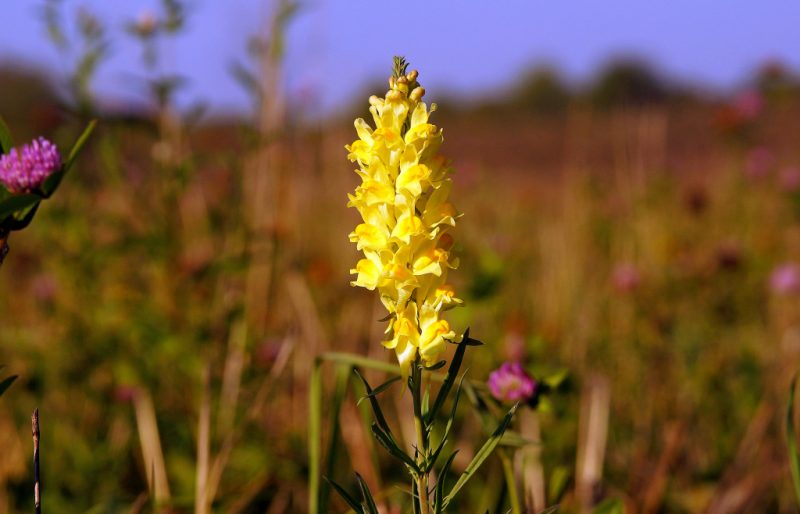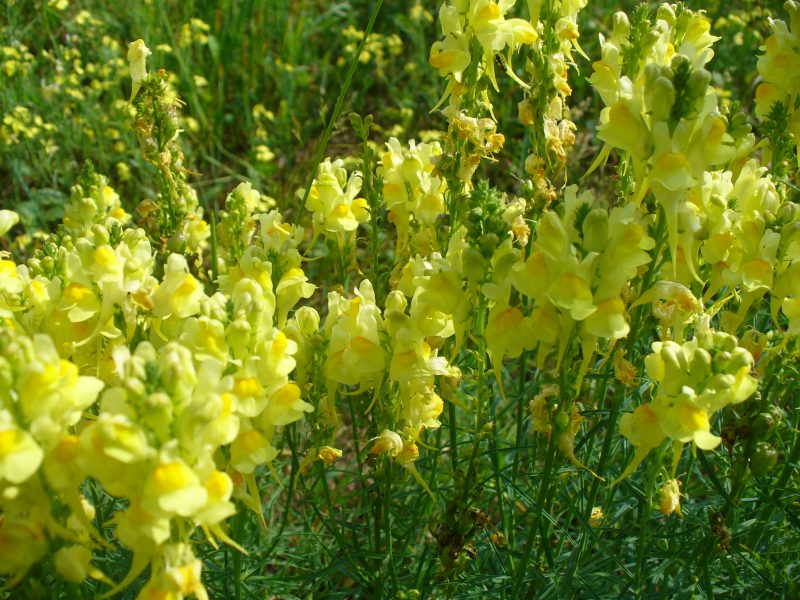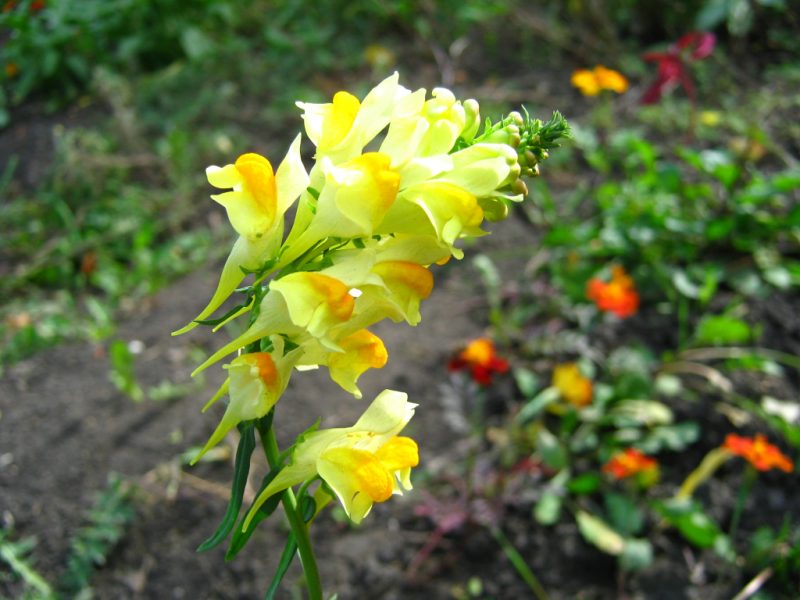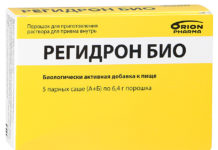Flax flax vulgaris is a perennial plant that not only pleases with its appearance (has a long stem and bright yellow inflorescences), but is also used for medicinal purposes. Do not forget that the roots of this herb are poisonous, so you need to work with them carefully. We will talk about all the nuances in today's article.
Material Content:
The chemical composition of flax flax
Flax flax is actively used in folk medicine. On its basis, ointments, decoctions, tinctures are prepared.

This is due to the fact that the grass contains a large number of useful components:
- fatty oils that favorably affect the work of the digestive tract;
- carotene. In the body, it turns into vitamin A, which is responsible for the proper functioning of the reproductive system. Often the plant is taken by girls who have problems with the hormonal background, can not get pregnant;
- choline. It is considered a natural antidepressant. Gently affects the nervous system, has a sedative, calming effect. Normalizes sleep, relieves insomnia;
- various acids. Especially valuable ascorbic and apple;
- tannins. They help to cope with inflammatory processes in the body. Can quickly stop bleeding;
- alkaloids. Normalize blood pressure, restore blood flow, lower blood cholesterol.
Flaxseed seeds are also useful. They contain a large amount of fatty acids, which are necessary for the full functioning of the brain centers.
The healing properties of the plant
The healing properties of flax flaxseed are clinically proven.

Grass is used in the form of:
- ointments;
- lotions;
- bath;
- decoctions;
- infusions.
The useful properties of flax are as follows:
- Quickly relieves constipation, adjusts the work of the digestive tract.
- Relieves swelling, removes excess fluid from the body.
- Restores the work of the intestines and kidneys.
- Improves appetite.
- It fights against fungal diseases and relieves inflammatory processes.
- Promotes the speedy healing of wounds, cuts, psoriasis.
- It has an analgesic effect. Can be used for sprain.
- Increases immunity, improves the general condition of a person.
From time immemorial, ordinary flax flax has been the main plant among healers and healers. There are legends about its properties. Serious illnesses were treated with grass in the villages. It was believed that if you drink flaxseed juice at a time when the stars line up in a certain order, then you can not get sick all year.
What diseases is flax used for?

What ailments can a plant cope with:
- digestive tract diseases. In particular, gastritis (even in an advanced stage), ulcers. It is used as a mild laxative for severe constipation;
- cystitis, pyelonephritis and other diseases of the liver and kidneys;
- inflammation of the skin (furunculosis, psoriasis, scabies);
- bronchitis, pneumonia, tonsillitis, laryngitis. In addition to the anti-inflammatory effect, flax flax has an expectorant effect, well removes sputum;
- worms and other parasites;
- jaundice. Reduces bilirubin levels;
- hemorrhoids;
- hypertension and hypotension;
- problems with the reproductive system. The grass helps to restore the menstrual cycle, to establish the level of hormones in the blood;
- anemia. Improves blood counts.
With any ailments, flax flax can act only as an additional means to the main treatment. The grass is not able to completely cure serious ailments. Self-medication can lead to complications.
Application in traditional medicine: recipes
Flax flax is actively used in folk medicine. There are many recipes. We will talk about the most popular and effective.

To prepare the infusion with bloating, increased gas formation, colic, you will need components:
- dried flax (without root) - 5 g;
- boiling water - 250 ml.
Cooking:
- Mix the ingredients.
- Put in a thermos.
- Let it brew for 30-50 minutes.
You need to drink tincture dosed. For adults: 15 g 4 times a day (before meals). Children are better not to give such a decoction.
People's advice:peppermint
This tincture also helps to cope with constipation, hemorrhoids, cystitis.

To prepare a decoction for gargling with sore throats, take the components:
- flax - 15 g;
- boiling water - 300 g.
Cooking:
- Mix the ingredients.
- Put on a slow fire.
- Let the broth boil and boil for another 5-10 minutes.
- Strain the tincture through cheesecloth or sieve.
You can gargle every hour. This broth has a pleasant taste, can be used for children.
Also, tincture will be an excellent prophylaxis for diseases of the gums, caries, and will help to avoid bad breath. If you take a decoction inside, it will help get rid of a strong cough with bronchitis.

If purulent wounds, boils, an allergic rash appear on the body, they will help to cope with the lotion problem.
Ingredients:
- flax - 90 g;
- boiling water - 300 ml.
Cooking:
- Connect the components.
- Let it brew for 2-3 hours.
- Strain through a sieve.
With this tool, you can wash your wounds daily, make lotions, leave them for several hours.
Flax ointment: cooking at home
To prepare flax ointment at home, you need to purchase any fat base. It can be petroleum jelly, coconut oil and much more.
Read also:Common Agrimony - useful properties and contraindications

Ingredients:
- flax flax - 80 g;
- dried eucalyptus leaves (can be replaced with mint) - 20 g;
- medicinal chamomile flowers - 20 g;
- fat base - 200 g.
Cooking:
- Prepare a water bath, melt the fat.
- Herbs must be ground. It is advisable to use a special mortar.
- Mix herbs with a fat base, simmer the mass on fire for 30-50 minutes.
- Let the mixture cool, strain it through cheesecloth.
You can use the ointment several times a day. It will help to cope with wounds, abscesses, bruises, sprains.
Collection and harvesting of raw materials
Flax flax is harvested in the middle of summer when the plant begins to bloom. It is better to do it in dry, sunny weather.

The root of the plant is poisonous, therefore, it is better to tear the grass with gloves, retreating from the ground up to 10 cm. Dry in a well-ventilated area, it is advisable that direct sunlight be prevented.
It is better to store raw materials in linen bags or cardboard boxes.
Read also:Tibetan lofant - useful properties
Contraindications to the use of plants
Flax flax has useful properties, but not everyone can use it.

Contraindications are as follows:
- pregnancy;
- oncology;
- children up to a year;
- cirrhosis of the liver;
- bleeding ulcer;
- renal and liver failure.
Flax should be taken dosed according to the instructions. Side effects may include bitterness in the mouth, tremor of the extremities, dizziness, and migraine. Before using the plant, it is advisable to consult a doctor.
It is interesting: medicinal properties and contraindications thyme herbs












